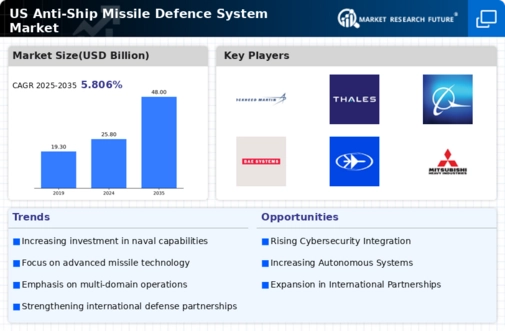Rising Geopolitical Tensions
The anti ship-missile-defence-system market is experiencing growth due to escalating geopolitical tensions, particularly in regions like the South China Sea and the Eastern Mediterranean. Nations are increasingly aware of the threats posed by naval adversaries, prompting them to enhance their maritime defense capabilities. The U.S. has allocated approximately $20 billion for naval modernization programs, which includes investments in advanced missile defense systems. This trend indicates a strong commitment to maintaining naval superiority and safeguarding maritime interests, thereby driving demand for sophisticated anti ship-missile-defence-systems. As countries seek to deter potential aggressors, the market is likely to see a surge in procurement activities, reflecting the urgency of addressing emerging threats.
Increased Naval Procurement Programs
The anti ship-missile-defence-system market is bolstered by increased naval procurement programs initiated by the U.S. government. The Navy's strategic shift towards enhancing its fleet's defensive capabilities has led to substantial budget allocations for missile defense systems. In 2025, the U.S. Navy's budget for missile defense is projected to exceed $10 billion, reflecting a commitment to acquiring advanced systems that can counter evolving maritime threats. This trend suggests a growing recognition of the importance of robust naval defense mechanisms, which is likely to stimulate market growth as manufacturers respond to the demand for innovative solutions in the anti ship-missile-defence-system market.
Strategic Partnerships and Alliances
The anti ship-missile-defence-system market is influenced by the formation of strategic partnerships and alliances among nations. Collaborative efforts in defense technology development and joint military exercises are becoming increasingly common, particularly among U.S. allies. These partnerships facilitate knowledge sharing and the co-development of advanced missile defense systems, enhancing collective security. The U.S. has engaged in several defense agreements, which may lead to a combined investment of over $5 billion in joint missile defense initiatives by 2026. This trend indicates a growing recognition of the importance of interoperability and shared capabilities, which is likely to further stimulate demand in the anti ship-missile-defence-system market.
Focus on Asymmetric Warfare Capabilities
The The market is increasingly shaped by the focus on asymmetric warfare capabilities.. As potential adversaries develop unconventional tactics, the U.S. military is adapting its defense strategies to counter these threats effectively. This shift necessitates the development of advanced missile defense systems that can operate in complex environments and against diverse threats. The U.S. Department of Defense has indicated that approximately 30% of its defense budget will be allocated to countering asymmetric threats by 2027. This emphasis on adaptability and resilience in naval operations is likely to drive innovation and investment in the anti ship-missile-defence-system market, as stakeholders seek to enhance their defensive postures.
Technological Innovations in Defense Systems
The anti ship-missile-defence-system market is significantly influenced by rapid technological innovations. Advancements in radar, sensor technologies, and missile guidance systems are enhancing the effectiveness of naval defense strategies. For instance, the integration of artificial intelligence and machine learning into missile systems is improving target acquisition and engagement capabilities. The U.S. Department of Defense has reported that investments in these technologies could reach $15 billion by 2026, indicating a robust focus on modernizing defense systems. This technological evolution not only increases the operational efficiency of existing systems but also drives the development of next-generation anti ship-missile-defence-systems, thereby expanding market opportunities.




















Leave a Comment